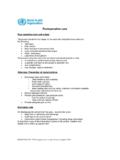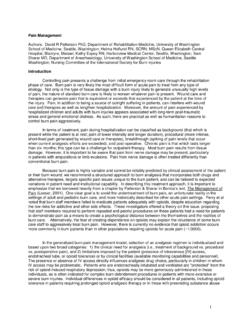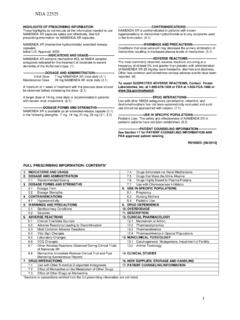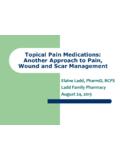Transcription of 1. PRODUCT NAME 2. QUALITATIVE AND …
1 NEW ZEALAND DATA SHEET 1. PRODUCT NAME ketamine 100 mg per 100 ml IV Infusion. ketamine 100 mg per 10 ml IV Injection. 2. QUALITATIVE AND quantitative COMPOSITION Each 100 ml of ketamine 100 mg per 100 ml contains ketamine hydrochloride equivalent to 100 mg ketamine base. Each 10 ml of ketamine 100 mg per 10 ml contains ketamine hydrochloride equivalent to 100 mg ketamine base. For the full list of excipients, see section 3. PHARMACEUTICAL FORM A clear, colourless isotonic solution for injection or infusion. It contains no preservative. It is formulated as an acid (pH to ) solution. 4. CLINICAL PARTICULARS Therapeutic indications ketamine is recommended: 1.
2 As the sole anaesthetic agent for diagnostic and surgical procedures that do not require skeletal muscle relaxation. ketamine is best suited for short procedures. It can be used for longer procedures with additional doses; 2. for the induction of anaesthesia prior to the administration of other general anaesthetic agents; 3. to supplement low-potency agents, such as nitrous oxide. Dose and method of administration Pre-Operative Preparation 1. While vomiting has been reported following ketamine administration, airway protection is usually afforded because of active laryngeal-pharyngeal reflexes. However, because these reflexes may also be diminished by supplementary anaesthetics or muscle relaxants, the possibility of aspiration must be considered.
3 ketamine is recommended for use in the patient whose stomach is not empty only when, in the judgement of the medical practitioner, the benefits of the drug outweigh the possible risks. 2. Atropine, hyoscine or other 'drying' agents should be given at an appropriate interval prior to induction. Dose As with other general anaesthetic agents, the individual response to ketamine is somewhat varied depending on the dose, route of administration and age of patient, so that the dosage recommended cannot be absolutely determined in a fixed manner. The drug should be titrated against the patient's requirements. Onset and Duration NEW ZEALAND DATA SHEET Because of rapid induction following the initial intravenous injection, the patient should be in a supported position during administration.
4 The onset of action of ketamine is rapid; an intravenous dose of 2 mg/kg of body weight usually produces surgical anaesthesia within 30 seconds after injection, with the anaesthetic effect usually lasting 5 to 10 minutes. If a longer effect is desired, additional increments can be administered to maintain anaesthesia without producing significant cumulative effect. Induction The initial dose of ketamine administered intravenously may range from 1 mg/kg to mg/kg. The average amount required to produce 5 to 10 minutes of surgical anaesthesia has been 2 mg/kg. Dose reductions should be considered in patients with cirrhosis or other types of liver impairment (see also section ).
5 Maintenance of Anaesthesia Increments of one half to the full induction dose may be repeated, as needed, for maintenance of anaesthesia. However it should be noted that involuntary and tonic-clonic movements of extremities might occur during the course of anaesthesia. These movements do not imply a level of attenuated anaesthesia and are not indicative of the need for additional doses of the anaesthetic. It should be recognised that the greater the total dose of ketamine administered, the longer will be the time to complete recovery. Paediatric population Currently available data are described in section but no recommendation on a dosage can be made.
6 Method of Administration Intravenous infusion or intravenous injection. It is recommended that ketamine infusion be administered slowly (over a period of 60 seconds). More rapid administration may result in respiratory depression and enhanced pressor response. This PRODUCT is for one dose in one patient only. Discard any remaining contents. Contraindications ketamine is contraindicated in patients with any condition in which a significant elevation of blood pressure would be hazardous such as: severe cardiovascular disease, heart failure, severe or poorly controlled hypertension, recent myocardial infarction, history of stroke, cerebral trauma, intracerebral mass or haemorrhage.
7 ketamine is also contraindicated in those who have shown hypersensitivity to the drug or its components. Special warnings and precautions for use 1. ketamine should be used by or under the direction of medical practitioners experienced in administering general anaesthetics and in maintenance of an airway and in the control of respiratory support. 2. Barbiturates and ketamine , being chemically incompatible because of precipitate formation, should not be injected from the same syringe. 3. Prolonged recovery time may occur if barbiturates and/or narcotics are used concurrently with ketamine . NEW ZEALAND DATA SHEET 4. Post-operative confusional states may occur during the recovery period (see also Emergence Reaction).
8 5. Because pharyngeal and laryngeal reflexes are usually active, ketamine should not be used alone in surgery or diagnostic procedures of the pharynx, larynx or bronchial tree. Mechanical stimulation of the pharynx should be avoided, whenever possible, if ketamine is used alone. Muscle relaxants with proper attention to respiration, may be required in both of these instances. 6. Resuscitative equipment should be ready for use. 7. Rapid administration may result in respiratory depression or apnoea and enhanced pressor response. 8. In surgical procedures involving visceral pain pathways, ketamine should be supplemented with an agent, which obtunds visceral pain.
9 9. Use with caution in the chronic alcoholic and the acutely alcohol-intoxicated patient. 10. An increase in cerebrospinal fluid pressure has been reported following administration of ketamine . Use with extreme caution in patients with pre-anaesthetic elevated cerebrospinal fluid pressure. 11. In patients with significant renal or hepatic impairment, the elimination of ketamine could potentially be delayed. Dose reductions should be considered in patients with cirrhosis or other types of liver impairment. 12. Patients should be cautioned that driving an automobile, operating machinery or engaging in other hazardous activities should not be undertaken for 24 hours or more (depending on dose and other drugs employed) after anaesthesia.
10 13. Use with caution in patients with increased intraocular pressure ( glaucoma) because the pressure may increase significantly after a single dose of ketamine 14. Use with caution in patients with neurotic traits or psychiatric illness ( schizophrenia and acute psychosis). 15. Use with caution in patients with acute intermittent porphyria. 16. Use with caution in patients with seizures. 17. Use with caution in patients with hyperthyroidism or patients receiving thyroid replacement (increased risk of hypertension and tachycardia). 18. Use with caution in patients with pulmonary or upper respiratory infection ( ketamine sensitises the gag reflex, potentially causing laryngospasm).














